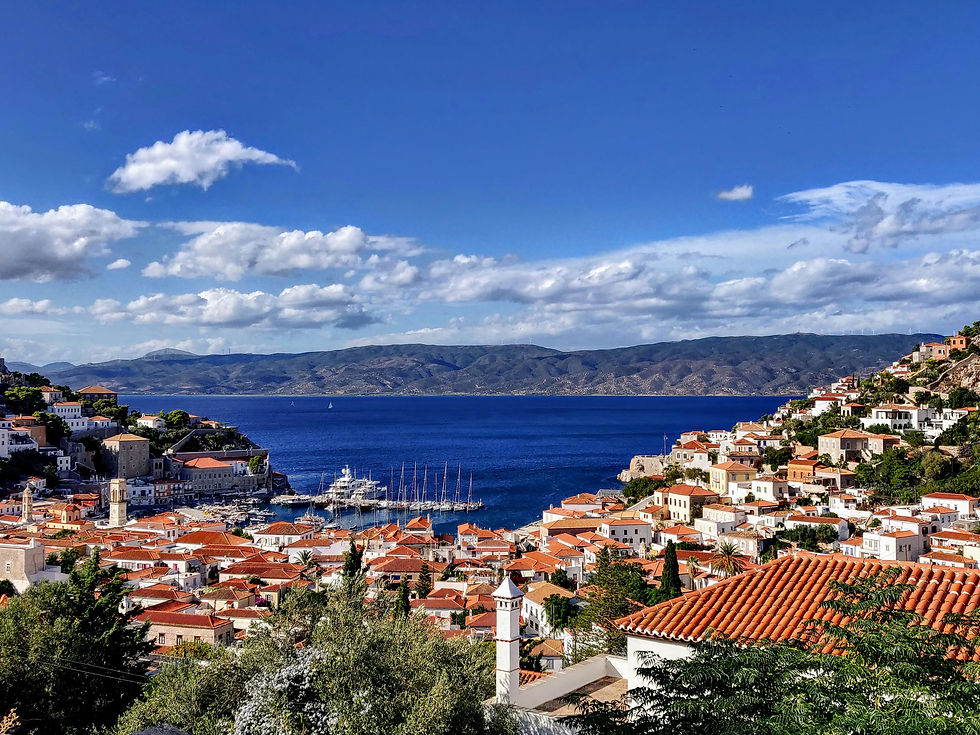THE GREEK ISLANDS UNPACKED. WHERE’S RIGHT FOR YOU?
- sueaitken7
- Sep 4
- 4 min read

Greece boasts over 6,000 islands and islets, but only about 200 are inhabited. And often this abundance of choice can feel overwhelming: which group of islands should you explore? Each has its own atmosphere, attractions, and travel quirks. Here’s a breakdown of the main island groups in Greece — along with the pros, cons, and a few must-see highlights.

The Cyclades (Santorini, Mykonos, Paros, Naxos)
Iconic whitewashed villages, blue-domed churches, sunsets, and lively nightlife.
Pros:
World-famous scenery (Santorini sunsets, Mykonos windmills).
Great ferry connections, making island-hopping easy.
A blend of glamour, tradition, and natural beauty.
Cons:
Can get very crowded in summer (especially Santorini & Mykonos).
Prices are high compared to other islands.
Strong summer winds (the Meltemi) can disrupt ferries.
Watch the sunset in Oia, Santorini — go early to claim a spot before the crowds. On Naxos, rent a car to explore mountain villages and less-frequented beaches.

The Ionian Islands (Corfu, Zakynthos, Kefalonia, Lefkada)
Lush green landscapes, Venetian history, and turquoise waters.
Pros:
Easier to reach from Western Europe (many direct flights).
Beautiful beaches and greenery unlike the drier Aegean islands.
Strong cultural mix: Italian influence in food and architecture.
Cons:
Less connected by ferry to the rest of Greece.
Can get very busy in package tourist hotspots like Zakynthos.
Has a less traditional “Greek island” feel compared to the Aegean
Visit Navagio (Shipwreck) Beach on Zakynthos — best viewed from the cliff-top lookout rather than the crowded shore. Wander Corfu’s UNESCO-listed old town with its Venetian fortresses and lively squares.

The Dodecanese (Rhodes, Kos, Symi, Patmos)
History-rich, close to Turkey, medieval towns, and laid-back charm.
Pros:
Excellent weather (season lasts longer than elsewhere).
Stunning medieval architecture, castles, and monasteries.
Good mix of busy resorts and sleepy smaller islands.
Cons:
Further from mainland Greece — fewer short-stay options.
Rhodes and Kos can feel very commercial in parts.
It's more effort to island-hop compared to the Cyclades.
Explore Rhodes’ old town — try to visit in the early morning before day-trippers arrive. Take a boat trip to Symi to see its pastel-coloured harbour and wander the narrow streets.

The Sporades (Skiathos, Skopelos, Alonissos)
Pine-covered hills, tranquil atmosphere, and scenic coastlines.
Pros:
Lush landscapes with hiking opportunities.
Less crowded than Cyclades or Ionian.
Great for those who want a quieter, more “authentic” Greek holiday.
Cons:
More limited ferry connections.
Smaller choice of flights and accommodation.
Skiathos gets very busy in high season due to its small size.
Take a boat to Lalaria Beach on Skiathos, only accessible by sea — go early before the excursion boats arrive. On Skopelos, hike the forest trails or visit Agios Ioannis chapel (famous from Mamma Mia!).

The Saronic Islands (Hydra, Spetses, Aegina, Poros)
Weekend getaways for Athenians, elegant and accessible.
Pros:
Very easy to reach from Athens (ideal for short breaks).
Hydra and Spetses are car-free, perfect for slow travel.
A good mix of culture, history, and beaches.
Cons:
Scenery isn't as dramatic as Cyclades or Ionian.
Popular with Athenians — can be crowded on weekends.
Smaller islands can feel pricey compared to further-flung ones.
Stroll along Hydra’s harbour — stay overnight if you can, as it’s magical once day-trippers leave. In Aegina, sample local pistachios and visit the well-preserved Temple of Aphaia.

Crete (technically its own group)
A country within a country — mountains, beaches, ancient sites, and fab food.
Pros:
Huge variety: from ancient ruins (Knossos) to stunning beaches and gorges.
One of Greece’s best food cultures.
Big enough to avoid the crowds if you venture beyond resorts.
Cons:
Size means you’ll need a car to explore properly.
Distances are long — not great for quick island-hopping.
Resorts in the north can feel quite touristy.
Visit the Palace of Knossos near Heraklion — hire a guide to bring the ruins to life. Hike the Samaria Gorge for dramatic scenery (start early, it’s a long trek).

Northeastern Aegean Islands (Lesvos, Chios, Samos, Ikaria)
Larger, less-visited islands with strong local traditions.
Pros:
Far fewer tourists — ideal for an authentic Greek experience.
Rich cultural traditions and unique local products (mastiha in Chios, ouzo in Lesvos).
Great value compared to hotspots.
Cons:
More remote and harder to reach (long ferry rides or limited flights).
Not ideal for first-time visitors who want classic “postcard Greece.”
Infrastructure and nightlife more limited than popular islands.
Visit the mastiha villages of Chios — unique to the island — and sample the local liqueur. In Ikaria, try the hot springs or join a traditional village festival where locals dance into the night.
Final Thoughts. Choosing the right Greek island holiday really comes down to what you’re looking for. If it’s your first time, the Cyclades or Ionian islands are the easiest introduction to postcard-perfect Greece. History lovers will find endless treasures in the Dodecanese or on Crete, while those in search of peace and natural beauty may prefer the Sporades or the more remote Northeastern Aegean. For a quick escape from Athens, the Saronic islands are hard to beat. Whichever you choose, every island group has its own character, traditions, and landscapes — and all of them promise that irresistible Greek mix of sunshine, sea, and warm hospitality.
Get in touch to plan your Greek Island adventure.




Comments